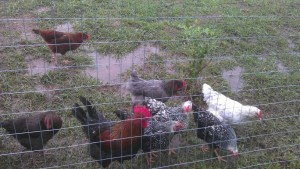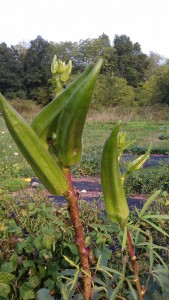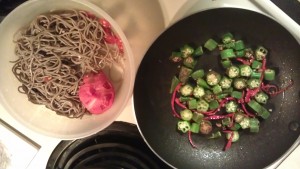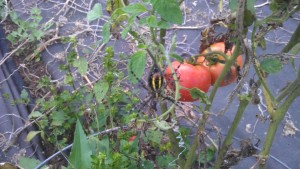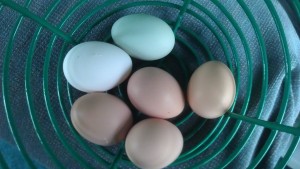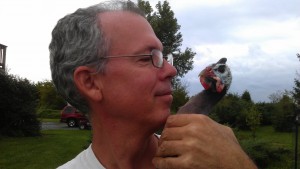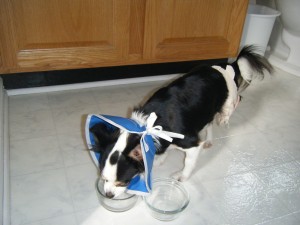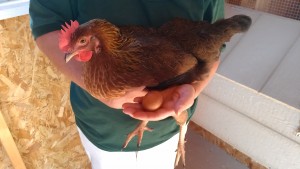
Enough rain already
0August, September, and now into October with warm, dry, sunny days I can count on my fingers. Momma Nature – enough already. My chickens are tired of wet feet. I think we have more than made up for the early summer drought. Might this mean that we will have a dry winter? In that case, OK, because I would rather have nine inches of rain now than eight feet of snow in January.
The chickens have slowed down laying partly because the days are getting shorter, but likely also in protest over this lousy dreary soggy weather. I can only hope that maybe this rain is driving some worms up to the surface and the chickens are getting the occassional treat.

Garden update
1The garden is different every year. It is planted with different crops in different rows and the size has increased somewhat each year. I am already thinking about where the expansion will take place next spring. But it always surprises me in some way. This year we planted a few new things including corn and okra. The corn was a minor disappointment (bugs got more corn than we did), but the okra was a real winner. We planted two varieties and I think one did better than the other, but both are still producing. I even planted a second half-row which is only now starting to flower and bear fruit. It looks terrific. Now this might not be as exciting if you don’t like okra, but I do and I am very pleased with the results. I have been eating a lot of it mostly broiled. With the new crop coming in, I hope I can get some in the freezer.
Another new crop this year was edamame. This is just a variety of soybean. I have never grown regular soybeans, so I really don’t know what the difference is. They have taken a long time to mature and are now just about right to start picking. They were planted a few weeks after the squash and about the same time as some as some other beans. The beans and squash are pretty much done producing, but the edamame is just beginning.
It seems like peppers always have a long growing season and this year is no exception. We have a good crop of Hungarian Wax which are my favorites – not too hot, not too bland, just the right amount of ‘heat’.
The thing that changes every year, of course, is the weather. Like last year, we had a drought this year. It was earlier this year than last occurring in June and July. Since then we have had a lot of rain. Like today, for instance – it’s been pouring for a few hours. The garden loves the rain in the long term, but without enough sun and hot weather, the plants just make lots of green stuff and not much fruit. The bees aren’t out pollinating when it is raining.
Most of the tomatoes have rotted or split open and they become chicken treats. I haven’t had a nice tomato for the kitchen in several weeks. I’m not sure if the rain helps or hurts with insects, but I did see a beautiful spider on guard in the tomato patch.
I still have hopes that we will get more tomatoes and that we can even can a batch or two. But it will depend on the weather. It probably won’t happen unless we get a stretch of dry hot weather in the next couple of weeks.

First Ameraucana egg
0Yesterday, we got our first Ameraucana egg of the year. About two thirds of our spring chickens are laying now and we have been holding our breath waiting for the two Ameraucanas to start. So yesterday was the day. No egg today, but that’s normal. When they start laying, we might get an egg every two or three days. I think it is probably Eleanor, but it could be Emily. Maybe I’ll catch one of them in the nest box tomorrow. Ameraucanas are ‘special’ because they lay the green-blue eggs. If you hadn’t guessed already, it is the egg at the top of the picture.

Guineas move to the Palace
0With the fencing finally up around the new, larger coop, it was time to move some birds from the smaller coops which had become too crowded. We tried moving a few of the older hens but they did not fare so well, constantly being picked on by the established residents and always in a panic to get back to their own flock. I felt so sorry for them that I moved them back. It was always our intention to have the guineas in the new area and allow them to fly in and out to roam as they pleased. Up until now, they were always in the yard that was covered by netting so we didn’t have to worry about them coming back to the coop each evening. I was not quite sure how to introduce them into the new, uncovered yard and allow them to get used to a new roosting area to be sure they would want to come back in the evenings. We couldn’t just keep them locked inside as the chickens needed to have access to the food and nest boxes. I had been thinking for some time about the best way to accomplish this move. The other night as we were moving the older hens back to their original coop, we came up with the idea of clipping the guineas’ wings to keep them from flying out of the fenced area for awhile, which would give them time to adjust to the new roosting arrangement. The operation ran smoothly, with no major injuries or blood loss (to us or the guineas). They are extremely fast and strong – difficult to catch and can really scratch you up trying to get away. Todd has become quite the guinea wrangler and was able to catch each one in turn and hold it properly for me to complete the wing clipping. They went into the new yard and seemed to settle in fairly quickly. The hens and roosters didn’t bother them since they don’t fit into the chicken pecking order and we found them roosting on the outside perch alongside the original occupants the very first night. I think it will take a few months for them to be able to fly over the fence and by then, they should want to come back to their customary roosting spot for the night. I think I feel better about keeping them in the fenced yard all winter as there are more hungry predators on the lookout for a meal during the colder weather, so we may have to clip their wings once more and let them start roaming next spring.

Abbie Normal Carpenter Stewart
1Our latest addition to the farm family – Abbie. She is a long haired Chihuahua that was relinquished to the clinic by owners who could not afford her care after she was hit by a car. The poor little thing had a dislocated hip and was in a lot of pain for some time. Even with the pain meds on board she gave a little yelp whenever we had to pick her up for treatment. She remained at the clinic for almost 3 weeks and I fell in love with her. Based on how she behaved at the clinic and in the cage, I thought she might turn out to be a pretty good little dog. I took Todd in to visit her a few times and he really liked her also, so we brought her home for a “trial” and to see if the other dogs would accept her. I wasn’t worried about Ellie at all, but Bob likes things to stay the same and has never really liked other dogs to visit. Well, I knew once I had Abbie at home there really wasn’t going to be a “trial” period – she would be ours, come what may with Bob and Ellie. As it turns out, little Abbie is the aggressive one and we have to keep her from biting both Ellie (who won’t retaliate even if bitten) and Bob (who just ignores her but will bite back if she starts something). She is so small and I am afraid that Bob could really hurt her if things get out of hand. They have had 2 unpleasant encounters so far which I was able to break up right away, but we can’t leave them together unattended for the time being. Abbie has to be on a leash or in her little cage when the others are in the same room. We are trying to walk them together as a group and have them around each other under supervision so I am hoping that things will improve with time. Abbie has not yet been spayed so perhaps that surgery will mellow her a bit as well. Other than the pack problems, she is an adorable little dog who has had no accidents in the house, stays in her cage whenever necessary without crying and sleeps soundly all night without making a sound. Her hip seems completely fine now and she likes to dance on her two hind legs and she likes to crawl – it’s so cute! Oh, her name is in appreciation of Igor (it’s pronounced “Eyegor”) from the Mel Brooks movie “Young Frankenstein”. 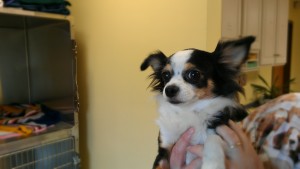
Egg chorus
1Our two year old hens are good and reliable layers. They were purchased as day old peeps in a package called, something like, “Ornamental Layers.” They were supposed to be unusual or exotic breeds that were also pretty good layers. We received a nice variety including White Crested Black Polish, Silver Phoenix, Mottled Hudan, Ameraucana, Crevecoeur, and Dominique. They are beautiful and have turned out to be pretty good layers. Some of the birds lay small to medium sized eggs, but a few lay nice large eggs.
Some days the girls spread out their laying throughout the day, but some days they seem to all want into the nest boxes at the same time. On those days it is not unusual to see three hens all squeezed into one box vying for a spot.
When a hen is getting ready to lay or has just laid an egg, she is often rather proud of her accomplishment and announces it to the world by squawking about it for a few minutes. When several hens are laying around the same time they will join in to produce a rather jubilant chorus. It might only last a few minutes, but it is something to hear. If nothing else, it is a reminder to me to go collect eggs soon.
Tale of two hives
0Today I must have smelled like a bear. Or maybe a skunk.
I was walking by my hives and I stopped to watch for a few minutes as I often do. I pulled out my new smartphone to shoot a short video of what I was seeing – one hive was as quiet as could be and the other was busier than I have ever seen it – so I thought I would document it. It was a beautiful afternoon and I was shirtless. I was perhaps 10 or 15 feet from the hives and shot the video without incident. As I was turning off the camera a lone bee decided I was a threat and I got stung on the face. Oh, right, no veil either today. I often sit quietly just a couple of feet from the hive entrance a little off to one side and watch or take pictures and I have never been harassed or stung before. But today was a different day. I got my first sting.

Late summer honeybee inspection
0I had not done an inspection in about a month, I think, until this past Friday, as Hurricane Irene was fast approaching. The results were interesting and encouraging. I had only just removed the entrance reducer a few days earlier, which I probably should have done a month or two ago, and there seemed to be lots of bees coming and going as well as more and more of them ‘bearding’ up along the front as well as under the screened bottom board.
I continue to feed them even if I don’t do an inspection. For August I have been using a 1:1 sugar to water mixture. The past two feedings I have used 10 pounds of sugar which means roughly five pounds in each hive. I pour the liquid in, so I don’t know if I get it distributed exactly half in each hive. Each time I feed, the liquid is completely gone and I am not sure if this ‘feast to famine’ technique is bad or not for the bees. I’m hoping not. I also switched the top board and feeding box. I used to have the top cover on the hive body and the feeding box on top of that. It was pointed out to me (thanks, Ed) that this was not such a good idea because it forced the bees to be in the center in order to reach the food. The top cover just has a small oval hole (about 2 in by 5 in). So now the feeder is right on top of the frames and can be accessed along the entire width of the hive box. This is followed by the top cover and the telescoping lid.
As you can see in the slide show, the Anaheim hive uses black plastic foundation and Boston uses all beeswax foundation. It is easier to see the comb development on the black foundation. I still don’t really know if there is any significant difference in what the bees like or in how well the two foundations function. As I worked my way in from the outer most frame on one side toward the center, you can see the increasing amount of comb being drawn. Anaheim also shows how much brood is being produced. Although I didn’t get a picture of her, I did spot the queen on the second or third frame. Assuming that she generally works her way from the center out, it was a good bet that there would be strong brood already in place toward the center. As you can see, as I made my way to frames three, four, and five the brood was indeed good there.When I closed up Anaheim and moved over to Boston, I found a different story. Recall that Boston has always been more active with more bees coming and going. I assumed that I would find even more brood in this hive. On the contrary, comb was about the same, but there was no brood at all. I don’t think the queen had even made her way up into the second story box. What I found instead of brood was some honey stores. There was not as much honey in Boston as there was brood in Anaheim, but I was happy to see any at all. i don’t know what hive development will look like moving into the fall, but storing honey must soon be the priority. Perhaps Boston has the population is needs now and is ready to store honey, whereas Anaheim is still needing to build its population and will start honey production in a couple more weeks. If this is so, then Anaheim is still the same two weeks behind Boston that is has been all season. I can’t wait to see what the hives look like in two weeks.
I major question I have at this point is should I be inspecting the lower box, too. It seems like it would be so disruptive, I really didn’t think I should do it. If I needed to, though, how would I go about it? Would I just lift the entire top box off frames and all? This problem will just get worse when a honey super is placed on top of the second brood box. I will need to ask some ‘experts’ about this.
Each time I feed the bees I am pouring the syrup into the empty feeder and disturbing the bees as well as the small hive beetles. I kind of like this process, because I get a snapshot of the population of beetles. This time was about the same as all the others. I probably saw and squashed about 10 to 15 in each hive. That doesn’t seem like an excess, so I continue to monitor and not put any traps into the hives.
One final note. I strapped the hives down just before the hurricane. It probably wasn’t necessary, but was easy to do and a good precaution. The wind was not quite as bad a predicted and the hives were fine.

First egg from spring chicks!
0This morning Todd found the first good egg from this year’s group of chicks. I found one a few days ago that was broken and empty on the coop floor, so this is the first one laid in a nest box and intact. We are pretty sure it is from Dory, one of our Welsummer hens. We saw her spending a lot of time in the nest boxes and heard her making “egg” noises for the last few days. Being from Dory is even more special because of her rough “chickhood”. She was a sickly little thing and had several bouts of respiratory problems that were so bad that I felt I had to keep her separated from the others. Keeping her by herself did have the benefit of making her more friendly as she was lonely and wanted us to hold her. A few times I really thought she might not even live so it is very rewarding to see that the extra special care that we put into raising her has helped her to become a healthy and now productive hen. The egg is a beautiful dark brown with even darker brown speckling – a little on the small side, as they all are when hens first start laying, but they should be up to a nice large size very quickly. Yeah, Dory! Show the others what they are supposed to do now!
Rain on the Bee Parade
0Normally, this might sound like a bad thing, but I think the bees are grateful for any drop of moisture at all. We got a shower and then the sun came out, followed by another shower and more sun. Each time the sun shows its face, the bees get quickly to work bringing in precious water, nectar, and loads of pollen. It seems they get more pollen in the morning then in the late afternoon, but I have never seen so much coming in to the hive as I did a few hours ago. I am implying from this that the queen is laying and the brood is being well fed.
I gave them a double batch of sugar water on Thursday and I am hoping that it holds them for a week. Now that I have a second brood box on each hive, inspecting is more involved. I think I just need to check the top box from now on unless I think there is a problem. Getting a peek into the bottom box will now take twice as long and be very disruptive to the hive. When I fed them, I could see that there was comb being drawn on many of the new frames, so that is a good start. If I can get comb on those frames for the start of next season, I will get a faster start than I did this year for sure.Because I continue to feed them the honey they are making won’t be good for harvesting, but will be great the bees over winter. I am beginning to think that I will have enough. If we can just get a little more rain, the fall nectar and pollen slow should be fine.
